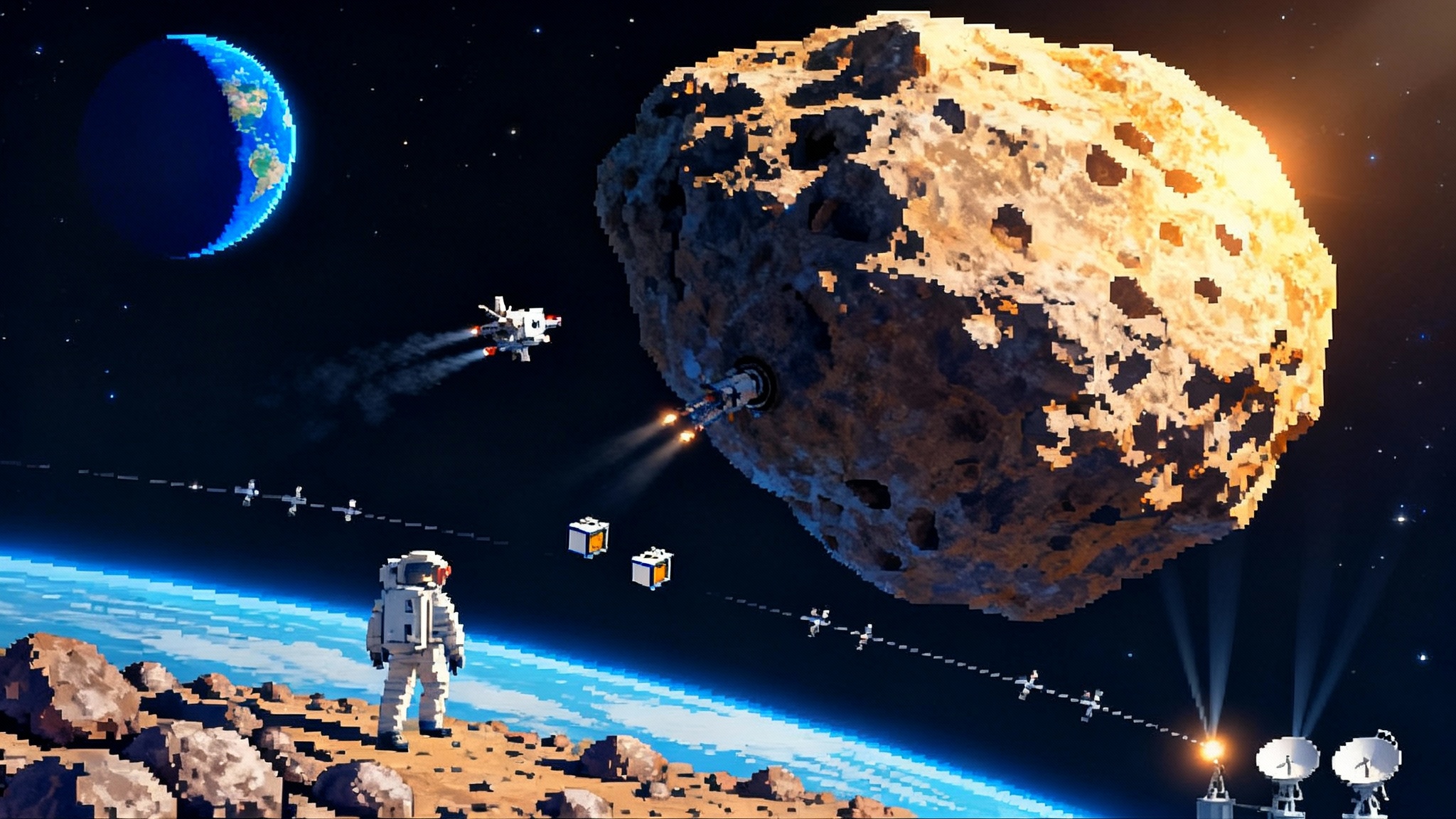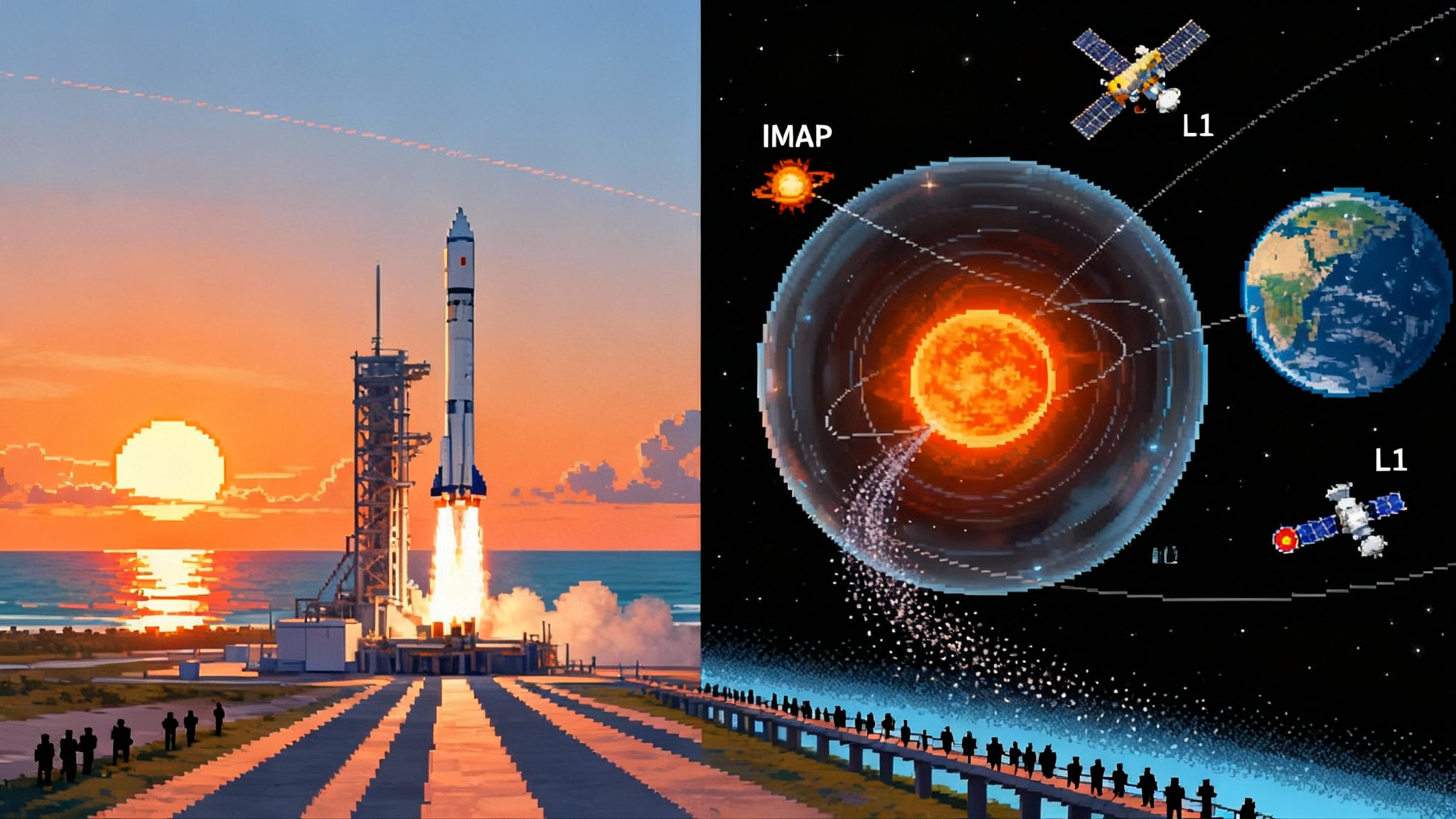Mars Sample Return, Rebooted: The 2025 Commercial Race
NASA’s 2025 reset opened fixed-price competition and Starship-class ideas, turning Mars Sample Return from one mega-plan into a sprint. What changed, who is bidding, how ESA’s orbiter anchors the mission, and why speed now matters.

A reset that turned one moonshot into a race
For most of the past decade, Mars Sample Return looked like a single towering project: a lander, a small rocket to launch rocks off Mars, and a European orbiter to catch the samples in space. It was bold and complex, and by early 2024 it had also become heavy and expensive. Then, on January 7, 2025, NASA said it would do something different. The agency announced it would carry two competing landing architectures forward in formulation and invite industry to aim for earlier and cheaper delivery under tighter incentives. It was not just a replan. It was a change in behavior, the kind you notice when a marathon turns into a 400 meter dash. NASA set the tone plainly in its NASA update on two landing paths, simplifying the design, switching surface power to a radioisotope system to avoid dust season blackouts, and redesigning sample loading to reduce external dust. The message was clear: move faster, reward those who can prove it.
The reset did not abandon the goal. Perseverance has already filled dozens of carefully sealed tubes in Jezero Crater, a site chosen because its ancient river delta stacks clay, carbonate, and igneous rocks like pages in a library. The question is how to get those pages home while the story they tell about ancient habitability is still fresh in our collective memory.
Why fixed price changes the game
For decades, the American way to buy one-off missions has been cost-plus. The government pays allowable costs plus a fee. That model is good at managing unknowns and protecting safety on first-of-a-kind hardware, but it can gradually shift risk and schedule ownership away from the builder and back onto the government. Fixed price, by contrast, forces a different calculus. Companies must price real risk, commit to delivery, and earn margin by executing well. It is the same logic that helped commercial cargo and crew flights to the International Space Station move from ideas to routine service.
In Mars Sample Return, that shift surfaced in two ways. First, NASA funded short, firm-fixed-price study contracts to gather fresh approaches in 2024. Second, by 2025 several players began publicizing architectures they were willing to execute as deliverable services rather than open-ended developments. One prime even stated it could deliver the end-to-end return for under three billion dollars on a firm-fixed-price basis. Whether that exact number survives risk review is less important than the signal it sends: companies are confident enough in their heritage and manufacturing to price the job and be accountable for it.
Think of it like hiring a contractor for a kitchen remodel. A time and materials contract means you discover problems as you go and keep writing checks. A fixed bid with milestones means the contractor eats the surprises that should have been foreseen. NASA’s pivot is asking space contractors to bring kitchen remodel discipline to a cathedral of engineering.
The front-runners and their bets
The studies NASA accepted opened the door for a very mixed field. That was intentional. If you want innovation, you do not ask a single shop to reinvent everything. You let different strengths compete and then stitch the best ideas into a coherent campaign. Here are the notable bets, distilled into plain English.
-
SpaceX: Envision a Starship-class heavy lifter doing what big rockets were built to do. One path has a giant vehicle send a large, integrated lander to Jezero with the Mars Ascent Vehicle, sample handling hardware, and the power to work through winter. Another path uses a heavy cargo platform to deliver the ascent stage and a transfer stage that can throw the sample container directly back to Earth, reducing rendezvous choreography. All of these depend on in-orbit refueling and on the steady maturation of Starship’s thermal protection, guidance, and landing systems. The upside is mass margin. Mass buys margin for reliability, larger sample capacity, and simpler mechanisms.
-
Blue Origin: The company’s bid is framed as leveraging Artemis investments. Translated, that likely means New Glenn for launch, and lunar lander and cislunar tug technologies adapted for Mars operations and interplanetary transport. The shared parts strategy is straightforward. If your avionics, propulsion, and docking systems are already being built for the Moon, reuse them wherever physics allows. For broader context on the launcher, see New Glenn targets Mars.
-
Lockheed Martin: This is the heritage play. Lockheed Martin built OSIRIS-REx, which grabbed pristine asteroid material and returned it to Utah in 2023. They are also deep in Mars aeroshells, parachutes, and cruise stages. Their proposal emphasizes an integrated, risk-balanced path with a firm-fixed-price offer, arguing that reusing proven designs, tightening the operations concept, and not over-customizing will cut cost and time. For background on the mission family, see OSIRIS-APEX and Apophis 2029.
-
Northrop Grumman and Aerojet Rocketdyne: These are propulsion-centric bets that go after the heart of the problem, which is getting something the size of a beachball off Mars reliably. Aerojet argues for a high-performance liquid Mars Ascent Vehicle engine using mature, testable technology. Northrop focuses on trades for high-heritage propulsion options and on the design maturity of the ascent stage itself. You can think of these as making the rocket in rocket science the schedule keeper it needs to be.
-
Rocket Lab: A nimble entrant with interplanetary experience on Photon, a small spacecraft platform that has already flown beyond Earth orbit. Their value proposition is sometimes summarized as smaller, sooner, and more modular. In a campaign that benefits from redundancy and the ability to host auxiliary sensors or communications relays, a company that can spin up small but capable deep-space buses has a role to play.
-
Quantum Space and Whittinghill Aerospace: These are targeted bets on specific segments. Quantum Space’s anchor leg framing hints at cislunar logistics and return-leg services. Whittinghill focuses on a single-stage Mars Ascent Vehicle design study that aims to reduce moving parts. One way to lower risk is to lower part count.
These study selections were publicly confirmed in 2024 in the NASA industry studies list, establishing the field and the direction of travel. Since then, teams have been iterating toward firm offers, integrating what the agency requested in 2025, from radioisotope power on the lander to simplified sample loading that reduces dust on the outside of the container bound for orbit.
ESA’s Earth Return Orbiter is the hinge
All roads still run through Europe’s Earth Return Orbiter, led by the European Space Agency with Airbus as prime. Think of ERO as the catcher’s mitt that does more than catch. It must find an orbiting sample container the size of a soccer ball in Mars orbit, fly up to it, capture it without contamination, seal it into a sterile vault, and shepherd an Earth entry capsule onto a precise trajectory for a landing at Utah Test and Training Range. ERO also doubles as a communications relay during critical surface operations. European teams have moved from paper to hardware, including orbit insertion module structures and avionics testbeds, and the platform has reached design maturity milestones. Even under a faster campaign, ERO remains the hinge that allows NASA to simplify the lander and ascent stage while protecting planetary protection requirements on the way home.
One subtle but important change in 2025 was how NASA framed ERO’s role in simplifying backward planetary protection. By redesigning the way Perseverance’s tubes are loaded into the orbiting sample container on the surface, the program reduces dust on the outer shell of what ERO must capture. Less dust outside means less risk that external contamination rides along with the treasured cores. That is an example of paying down risk with design, not paperwork.
The parts NASA trimmed or changed
The 2022 concept had a Sample Retrieval Lander with a pair of mini helicopters to pick up dropped tubes if Perseverance could not deliver them. The 2025 thinking assumes Perseverance will do the handoff directly and that the lander should use a radioisotope system for power and heat instead of solar arrays. Two consequences follow.
- Fewer moving pieces. Every new vehicle on Mars means new failure modes. Removing the helicopters simplifies operations and testing.
- Schedule flexibility. Radioisotope power ignores dust storms. If your plan depends on solar, your operations dance around winter. If your plan uses a warm, steady power source, you can load samples when it is scientifically and operationally optimal, not just when the weather cooperates.
For a sense of how commercial cadence is reshaping lunar logistics, compare with commercial moon landings in 2025.
Planetary protection and curation, explained simply
Bringing rocks from a world that could once have hosted life triggers the strictest biosafety playbook we have. The formal label is Category V, Restricted Earth Return. The idea is simple, even if the implementation is not. Keep the samples sealed from the moment they leave the Martian surface until they are inside a controlled facility on Earth. Confirm they are safe to release to science, or sterilize them if necessary, without destroying the information scientists care about.
Picture a set of nested dolls. Inside the innermost doll are the cores that Perseverance drilled and sealed. That doll slides into the orbiting sample container. That container rides inside a capture, containment, and return system on the European orbiter. That system loads an Earth entry capsule designed to survive a pinpoint plunge into the Utah desert. After landing, the capsule is moved under escort to a purpose-built Sample Receiving Facility. Only there will the outer dolls be opened by people in negative-pressure rooms using double-walled gloveboxes and tools that have been sterilized and tracked like surgical instruments.
The facility itself will be a hybrid of a high-end cleanroom and a biosafety level 3 or 4 lab, with redundant air handling and layers of barriers that ensure anything that could conceivably hitch a ride stays contained until characterized. NASA’s Astromaterials Research and Exploration Science team at Johnson Space Center will lead the curation program with European partners. The design challenge is that the samples must remain pristine enough to measure delicate organic compounds and isotope ratios that tell a story about ancient water and potential biosignatures, yet secure enough that we can rule out any risk to Earth’s biosphere. The 2025 simplifications to loading and dust control are small but real steps toward threading that needle.
What faster return unlocks in the 2030s
Speed is not just a headline. A return in the early or mid 2030s would reshape planetary science and human exploration planning in three concrete ways.
-
Science cadence. The instruments that can most credibly distinguish between abiotic organic chemistry and traces of ancient microbial life do not fly on rovers. They fill rooms. Imagine seeing the fine layering of a delta clay under a transmission electron microscope, measuring carbon isotopes with parts-per-thousand precision, and mapping fossilized textures across a thin section at nanoscale. If those data arrive before the decade is out, they will shape what the next rovers drill and where they go.
-
Landing site decisions for crews. Artemis is already forcing hard choices about lunar sites based on volatiles and terrain. Mars will be harsher. Where we send the first crews will depend on engineering safety, resource access, and science value. The ground truth from Jezero cores can validate models of dust stickiness, rock strength for drilling, and the abundance of certain minerals that affect dust toxicity and habitat filtration design. Those are not abstract. They tune life support systems and the design of excavators.
-
Proving ascent from Mars. Launching a small rocket from another planet is the hinge technology for any crewed Mars mission. Even a tiny Mars Ascent Vehicle is a system-level test of guidance, propulsion, thermal design, and ground operations under Martian gravity and atmosphere. If the ascent stage works on schedule, it de-risks the architecture for later human flights in the same way that commercial cargo paved the way for commercial crew to the Space Station.
Risks that still bite
A reboot does not abolish physics or budgets. Three big risks remain visible.
-
Heavy lifters must mature. Big rockets can simplify Mars by brute force, but they make new promises. In-orbit refueling must move from demonstrations to reliable service. Thermal protection and landing guidance must survive repeat cycles. If those pieces slip, architectures that depend on them will slip too.
-
ERO is the singular hinge. The European orbiter carries the most delicate choreography of the campaign. It must be ready on time and must achieve its capture and containment performance on the first try. European teams have put real metal on stands, but the integration calendar will be tight.
-
Money and focus. A fixed-price race helps, but it does not replace appropriations. If the program sees peak-to-valley funding swings or a gap in radioisotope power system availability, schedules will stretch. The most important near-term events to watch are NASA’s downselect in 2026, long-lead procurements like aeroshells and radioisotope generators, and hot-fire tests of ascent engines under Mars-like conditions.
There is also the global context. China’s Tianwen-3 aims at a relatively direct sample return in the early 2030s. Competition does not make your rocket lighter, but it can keep your calendar honest. The scientific community would genuinely benefit from samples from two very different places on Mars. The geopolitical community will keep score on who arrived first.
What to watch in 2026
NASA has said it will confirm the program and select a single path in the second half of 2026 after the strategy team finishes assessing cost and schedule. Between now and then, look for these telltales that the commercial race is translating to progress.
- Lander power hardware moves to qualification, showing the radioisotope system is locked in and thermal is closed.
- A clear, testable interface definition between the lander loading system and the orbiting sample container, with dust-control verification that is audited and repeatable.
- Ascent engine hot-fires at relevant temperatures and pressures, with ignition and throttling margins published.
- ERO subsystem integration photos and propulsion system pressure tests, followed by platform-level environmental testing.
- A publicly named site and early construction planning for the Sample Receiving Facility, with a joint NASA and European curation team releasing procedural drafts for peer review.
- A final fly-off between one heavy-lift anchored architecture and a more modular, multi-launch architecture, with side-by-side risk burndown plans instead of slide decks.
If those signs appear by mid 2026, the choice in the second half of the year can be driven by demonstrated performance rather than promises.
The bottom line
NASA’s 2025 pivot did not make Mars Sample Return easier. It made it executable. By forcing the conversation into fixed-price offers, parallel architectures, and simplifications that cut risk without cutting science, the agency created a market for speed and reliability. Europe’s orbiter gives the campaign a backbone. Industry’s heavy lifters and heritage sample-return teams supply the muscle memory and the mass margin. Planetary protection and curation will be the adults in the room, insisting on nested containment and patient, disciplined handling.
The prize is not only a set of rocks. It is a clock. If the first Jezero cores arrive on Earth in the early or mid 2030s, they will set the pace for life detection and steer the design of the first human systems that must work the first time. That is what this new race is really about: not speed for its own sake, but speed that buys certainty, the kind of certainty you want before you ask people to breathe Mars air filtered through machines you built.








